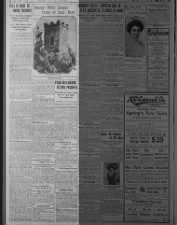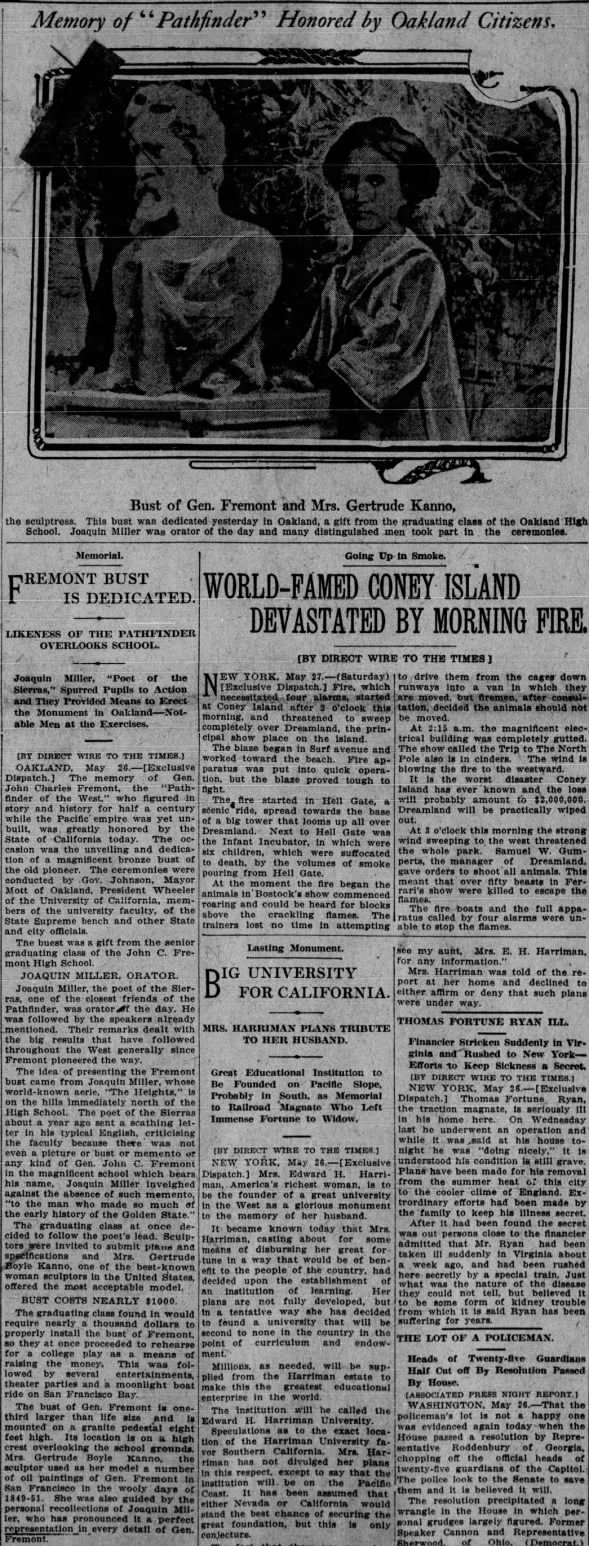 PLEA IS MADE TO HONOR FREMONT
TO BLOG Sun, Jan 22, 1911 – Page 26 · The San Francisco Call (San Francisco, California) · Newspapers.com
PLEA IS MADE TO HONOR FREMONT
TO BLOG Sun, Jan 22, 1911 – Page 26 · The San Francisco Call (San Francisco, California) · Newspapers.com[See also this recent post, EARLY DAY NOTES ON LINCOLN AVENUE. regarding the Bierstadt painting. I'm guessing it's lost, but would love to find it, or find out more about it. Thanks to Michael D. Manning for the clip, above. One thing you should know, and this is my opinion; Joaquin Miller was a tale-spinner. Many of his stories are good, but don't bear up under scrutiny. Since most of the first-person evidence doesn't exist, we'll have to enjoy the stories. One more thing to consider; in 1911 California, Fremont was a hero. Later historians shined a brighter light on his record, showing human mistakes and failings. As far as I can tell, Fremont never mentioned Miller in his letters or reports. - MF]
PLEA IS MADE TO HONOR FREMONT
Poet of the Sierras Addresses Audience at School Bearing Path Finder's Name
Fund Is Being Raised to Place Bronze Bust of Explorer in Front of Building
OAKLAND, Jan. 21. - The life of the soldier, statesman and path finder, John C. Fremont, who made history in California before it was a state and declared its independence from Mexico, was the subject of an address tonight by his admirer and friend, Joaquin Miller.The talk was part of the program at the high school bearing the explorer's name and was given in aid of the campaign to raise funds to purchase a bronze bust of the explorer to be placed in front of the school.
Miller, in opening his address, spoke of Fremont as one of the greatest men who ever lived. When Miller was a boy his father, who knew Fremont well, corresponded with Fremont. Thus the name of Fremont was familiar to Miller. The father of the poet's mother, John D. Witt, and Daniel Boone were first cousins. Kit Carson, who accompanied Fremont on his trip across the continent, which took him into Oregon and later into California, was related to Boone and this relationship and the friendship Fremont had for Miller's father caused Fremont and Miller to become close friends.
MILLER TELLS OF HARDSHIPS
"When Fremont first came to California he and his party traveled in the foothills because of the scarcity of water in the plains," said Miller. "From my home on the heights I can show you the path that Fremont trod. And it was near the spot where I have raised a monument to Fremont, which I call the tower, that he viewed the beautiful Golden gate, and because of its resemblance to the horn of the Hellespont named it Golden gate. Years later his widow, Mrs. Jessie Benton Fremont, who died some years ago in Los Angeles, came to visit me. As she walked about my grounds and saw the splendid view they gave of the Golden gate, she told me that it was there that her husband had stood when he named the picturesque entrance into San Francisco bay.It was on The Hights, Joaquin maintained, that Frémont his childhood hero had camped decades before, and, looking down, with that glorious flash of Inspiration, had named the strait in the distance the Golden Gate. Joaquin may have been right, for, although the exact position of that historical spot is unknown, it is believed to have been somewhere in the vicinity of The Hights. Besides, Joaquin's claim could not be affirmed or denied by Frémont, for he was dead.From Splendid Poseur: The Story of a Fabulous Humbug, by M. M. Marberry
FREMONT LOVED THE HILLS
"Writing to me from Los Angeles in 1896 Mrs. Fremont said:"Mr. Fremont in later years would point out to me when we went upon one of our rides the Contra Costa hills and tell of their beauty, known only to horsemen. He loved great bare rocks. When a New York friend wrote to me of an intended monument to the general I asked that they spare him the sadly unmeaning stones that usurp our finer ideas. If they must, then put up a great rock, a rough map of granite, and carve his name in it. He felt the strong, immovable power that grasped the heavens and the earth and on it put only his name.'
"Upon another occasion Mrs. Fremont wrote to me: "When Bierstadt, the painter, came to California to study its scenery (and the Rocky mountains en route) we gave him letters to Starr King and other friends. It was about April, 1863. In giving him a commission to paint for us the Golden gate with the setting sun lighting the pathway I clearly remember Mr. Fremont saying he must see the sunset from the Contra Costa hills, as he had to realize the force and splendid appropriateness of the name in its scenic sense, apart from the other idea of the gateway of commerce. Bierstadt painted a grand picture. When we had to sell what would bring needed money Commander Garrison bought it for $4.000, just what we had given Bierstadt.'
64x39.75 From J. C. [John C.] Fremont
Note with check for $4000. “I promise myself much pleasure in seeing the picture at the Academy.”
From the Alfred Bierstadt collection at Winterthur Academy
POET SAW BIERSTADT PAINTING
"I can remember early in the sixties when I first came into the hills where I make my home. The country was bare of trees. I noticed an artist busy at a picture, and it was Bierstadt painting the Golden gate. Then and there I purchased part of the property which I own and have since planted thousands of trees and made it a paradise. |
| This is from "The Portrait Gallery", a blog. I have no way of knowing whether it's the painting Miller references. |
"In reference to the Bierstadt picture I wish to tell you of another, drawn by the first great artist who ever came to California - Jewett. He met Mr. and Mrs. Fremont in California and the artist wished to paint the picture of Fremont. No suitable canvas was to be had, so Jewett hit upon the idea of painting the likeness of the great soldier and statesman upon a French table cloth. And this was the only picture of Fremont which was ever painted. It was given to me by Fremont and for many years it hung upon the wall in my mother's house on the heights. After her death I had it sent to Berkeley, because I feared it might be stolen, and it is still there. I intend to secure this unique picture and give it to this school, where it should occupy a place of prominence. I think this would be a much better souvenir of Fremont than the bronze bust you intend to buy. [More about Jewett here. No mention of Fremont or Miller. - MF]
PATHFINDER WAS MODEL MAN
The letters which I have from Mrs. Fremont and from which I have read extracts to you I shall also turn over to the school. It is unfortunate that I should have kept none of the letters I had from Fremont. They would have shown more clearly than anything else the splendid type of man he was. He never drank, smoked or swore. I remember that upon one occasion a stranger was visiting him. It was at dinner and the stranger started to tell a story which Fremont thought was not proper. He immediately got up and left the table. He was a very reserved man and never laughed. A splendid scholar, he never made a mistake. A born leader of men, he gained the confidence of every man. He was of a forgiving disposition and when Lincoln was nominated the second time for president was urged to run against him because Lincoln had once removed him from office. Fremont declined and said he would work for Lincoln. And much of my own success in life I attribute to my knowing Fremont and trying to follow his example." |
| Tower erected by Joaquin Miller on spot where John C. Fremont saw and named the Golden Gate. |
Miller told of the Fremont expedition, which started in 1843. Fremont was placed in charge by his father in law, Thomas H. Benton. The expedition was to protect Oregon from the English at the time war was threatened. Fremont made the trip in the winter. He arrived in Oregon and went down to the mouth of the Columbia river, where he patrolled the country until fear of attack was abated. He returned to the east of the Oregon Sierras and traveled along the foothills until he came to Sutter fort. When he reached there he was halted by the Mexican officials and ordered to leave the country.
"Fremont then explored the country to find a new route to Oregon. He went into the Klamath country, where he was attacked by Indians. Just before the attack he received mail which informed him of war between the United States and Mexico and ordered him to return to California. The Indians were routed and Fremont with his depleted force returned to Fort Sutter.
BEAR FLAG RAISED
"Shortly after this he raised the bear flag and declared California a portion of the United States. He took Commander Vallejo prisoner, captured the towns of Santa Barbara and Los Angeles with a force of several hundred men and sent dispatches by Kit Carson to Washington.
"The rest of Fremont's life was equally interesting. He was one of the first United States senators from California and was prominent in drafting the constitution of the state. On account of delays in admitting the state to the union he served but one year at Washington and after that devoted his time to developing the resources of the famous Mariposa grant. Later he lost this. He was the first candidate for president of the new republican party in 1856. He won distinction as a general in the civil war and was in public life until 1881.
WIFE WAS A GREAT AID
"No story of Fremont is complete without a word or two about his wife. She was the daughter of Thomas H. Benton, and through all Fremont's trying labors and during the times he was under fire, which were many because of the petty jealousies of men opposed to him, she was faithful and always a firm believer in his actions. It is related that when Benton was told Fremont was a suitor for his daughter's hand he said: 'No, sir, I will not. I will give him hell.' To this Mrs. Benton, who was present, replied, 'Better give him Jessie.' And he got Jessie.
"One thing which I have often observed is this: It is the custom to raise monuments to our great men and to show them other honors. Fremont has been absolutely overlooked. There is no monument to him. No city, town, river or even public building is named after him. Outside of this school I know in no way in which his name is commemorated - always excepting the tower I have constructed for him on the heights. I suggest that something be done at this late day to remedy this."
A large sum of money was added to the fund tonight and it is probable the bronze bust will be purchased in the near future.
--
It appears the bronze bust was created by Gertrude Kanno, one of Joaquin Millers friends and protégés:
 Sat, May 27, 1911 – 1 · The Los Angeles Times (Los Angeles, California) · Newspapers.com
Sat, May 27, 1911 – 1 · The Los Angeles Times (Los Angeles, California) · Newspapers.com


Comments
Post a Comment